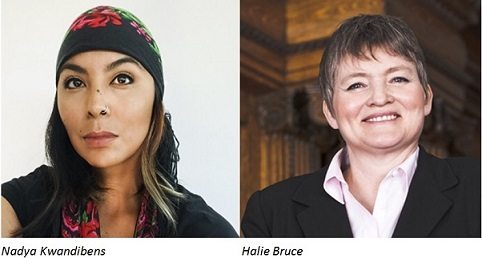
A Project of the Indigenous Laws + the Arts Collective
CLEBC is proud to support Testify: A Project of the Indigenous Laws + the Arts Collective. Happening now until October 21, Testify is a performance and art show in which 11 pairs of artists and legal thinkers work in conversation with each other to create pieces that explore Indigenous laws.
A project in partial response to the Truth and Reconciliation Commission (TRC), Testify aims to change the way we think about law and challenges the absence of Indigenous law in the legal landscape.
CLEBC had the opportunity to chat with artist Nadya Kwandibens and lawyer Halie Bruce, one of the Testify pairs, about their work which seeks to challenge the concept in Canadian law that “culture abates over time”.
The “culture abates over time” concept was first introduced by the Supreme Court of Canada in Racine v. Woods in which an Indigenous mother sought custody of her daughter placed in the child welfare system. In that case, the court stated that “in determining the best interests of the child, the significance of cultural background and heritage as opposed to bonding abates over time.”
However, having both grown up in the Indigenous child welfare system, the concept that “culture abates over time” has always been incongruent not only with Halie and Nadya’s own lived experiences, but also with the experiences of many other Indigenous children.
Through a beautiful, tragic, and hopeful video encapsulation, Halie and Nadya’s work uniquely portrays the child welfare system experience. “We wanted to center the piece on an Indigenous child’s perspective and all the different emotions associated with going through the system,” said Nadya.
Shown simultaneously on flat screen panels, three videos move from conveying a sense of separation in the first video, to the experience of confusion in the second, and finally in the third, a depiction of a return to and strengthening of culture rather than abatemnt. Accompanying the visual installment is also a written piece that explores the missing recognition of Indigenous laws (often expressed through art) in our current understanding of Indigenous child welfare.
To complete their work, Nadya moved into Halie’s home for a number of weeks in order to be able to work closely together. “It was an intense experience, but one that was cathartic and human. It brought forward our difficult personal experiences, but was deeply enriching. I think our work is a great reflection of the dialogue that we hope to inspire about child welfare,” said Halie. “Hopefully, people are transformed from viewers into participants, and begin to discuss what we need to do to transform the law.”
When asked why Testify project is important, Nadya responded: “Testify shows the importance of Indigenous laws and shares a framework within Indigenous culture that is uplifting and potentially more beneficial than our current framework.” For Halie, the Testify project is also a way to give meaning to the recent TRC Calls to Action and to begin creating a practical solution for a way forward.
Nadya and Halie want to encourage those in the legal community to be open and attend Testify without preconceptions. “If we hope to work together to transform the law so that it provides security for everyone, we need to start opening our minds and hearts to other ways of thinking.”
To view Nadya and Halie’s work and all the other amazing Testify project pieces, visit Loungeworks Pop Up Gallery at 130 West 4th Avenue now until October 21 from 10:00am-4:00pm. Attendees at our Aboriginal Law Conference 2016 on November 25 will also have the opportunity to view a few Testify project pieces during a lunchtime presentation.




